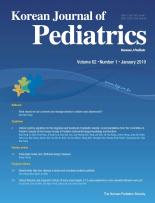Pediatric obesity is an emerging key health issue worldwide, including South Korea, because not only is the prevalence of obesity increasing but also the prevalence of obesity-related metabolic and psychosocial comorbidities [1,2]. Because a significant portion of untreated childhood obesity is linked to adult obesity and consequently increase future morbidity and mortality, it will become a major health problem and a big medical expenses burden in the future. From a disease prevention and control perspective, timely interventions to prevent and manage obesity and its complications early in life may be a good solution to save direct and indirect medical costs. Therefore, practice guidelines for evidence-based systematic strategies are beneficial to diagnose and treat obesity effectively in children and adolescents.
Previously, several guidelines have been published on the prevention and management of childhood overweight and obesity, particularly in the European countries, Canada, and Australia. Most of them are basically evidence-based guidelines with systematic reviews, approached by the level of evidence and the grade of recommendation to formulate evidence-based recommendations [3-5]. These guidelines consistently recommended the screening of all overweight and obese children and offering of structured counselling and multicomponent behavioral interventions that improve weight status by increasing physical activity levels, decreasing inactivity, and improving dietary intake and eating behavior on the basis of their own data and evidence [3-5]. However, to date, there has been no clinical guidelines or consensuses on pediatric obesity diagnosis and treatment in Asian countries including South Korea, despite the clinical significance of childhood obesity in Asia.
In the current issue of the Korean Journal of Pediatrics, the Committee on Pediatric Obesity of the Korean Society of Pediatric Gastroenterology Hepatology and Nutrition newly developed and announced the first evidence-based Korean Guideline on the diagnosis and treatment of obesity in children and adolescents [6]. According to this guideline, based on evidences from South Korea and worldwide, family-based comprehensive multidisciplinary behavioral interventions for lifestyle modification such as calorie-controlled balanced diets, reduced sedentary habits, and increased physical activity and exercise are mainly recommended to manage overweight and obesity in children and adolescents. And, there was no and limited evidence for the effect and safety of pharmacotherapy and bariatric surgery in children and adolescents, respectively.
Pediatric obesity cannot be controlled by individual efforts alone. The interventions to prevent and manage childhood and adolescent obesity should be supported by all family members, schools, communities, and even government policies.
The pediatrician’s role as a childhood obesity expert is also important for effective obesity and comorbidity treatment in children and adolescents [7]. Since the most important pediatric obesity treatment goal is not a weight loss but a healthy lifestyle, all pediatricians should try to offer consultations on having healthy lifestyle to overweight and obese children. For better practice, long-time counseling compensation such as consultation fees covered by the National Health Insurance should also be realized.
All children should undergo obesity prevention and treatment to maximize the effect of the intervention. However, until now, only a small portion of obese children have been treated through primary care or obesity clinics in hospitals, and most of the other obese children and adolescents have been in the blind spot of care.
As part of the solution, it may be necessary to link up the current Korea health screening programs such as the National Health Screening Program for Infants and Children with clinical care by pediatricians [8]. For this purpose, an integrated government system that provides comprehensive hospital care management in conjunction with home, school, and community is also required. Thus, it would be a good idea to designate and operate the Pediatric Obesity Center that comprises a multidisciplinary team of pediatricians, dieticians, exercise specialists, and coordinators in regional hospitals. In addition to the connection with family, school, and community, this center may also provide an integrated referral system between primary care physicians and specialty clinics for the systematic management of childhood obesity.
Additionally, from the prevention, assessment, and treatment of childhood and adolescent obesity perspective, the implementation of educational programs at the national level similar to the Health and Obesity: Prevention and Education curriculum project in the United States might be necessary to educate pediatric clinicians on how to identify children at risk of obesity and its comorbidities and how to promote healthy weight among children and their families [9].
Individual-, family- or community-based obesity interventions which focus on behavior modification alone may have limitations in changing the prevalence of childhood obesity. Since prevention is a better strategy than treatment, government-level policies and health promotion education are fundamentally needed to prevent childhood obesity and thus, reduce the prevalence of children and adolescent obesity.
Regarding education, safe environments for proper physical activity and exercise and healthy school meals and snacks should be secured, and health education and programs should be regularly provided to students and parents in the school and community.
Government policies on childhood obesity should include food advertising and safety issue regulations comprising the labeling and establishment of a consultative body involving all metropolitan and provincial offices of education, municipalities, and government ministries linked to school health and public health. Ultimately, legislation is required for government budgets and sustainable policies on childhood obesity. As childhood obesity is an important public health priority, it should be approached and managed from a long-term perspective.





 PDF Links
PDF Links PubReader
PubReader ePub Link
ePub Link PubMed
PubMed Download Citation
Download Citation


